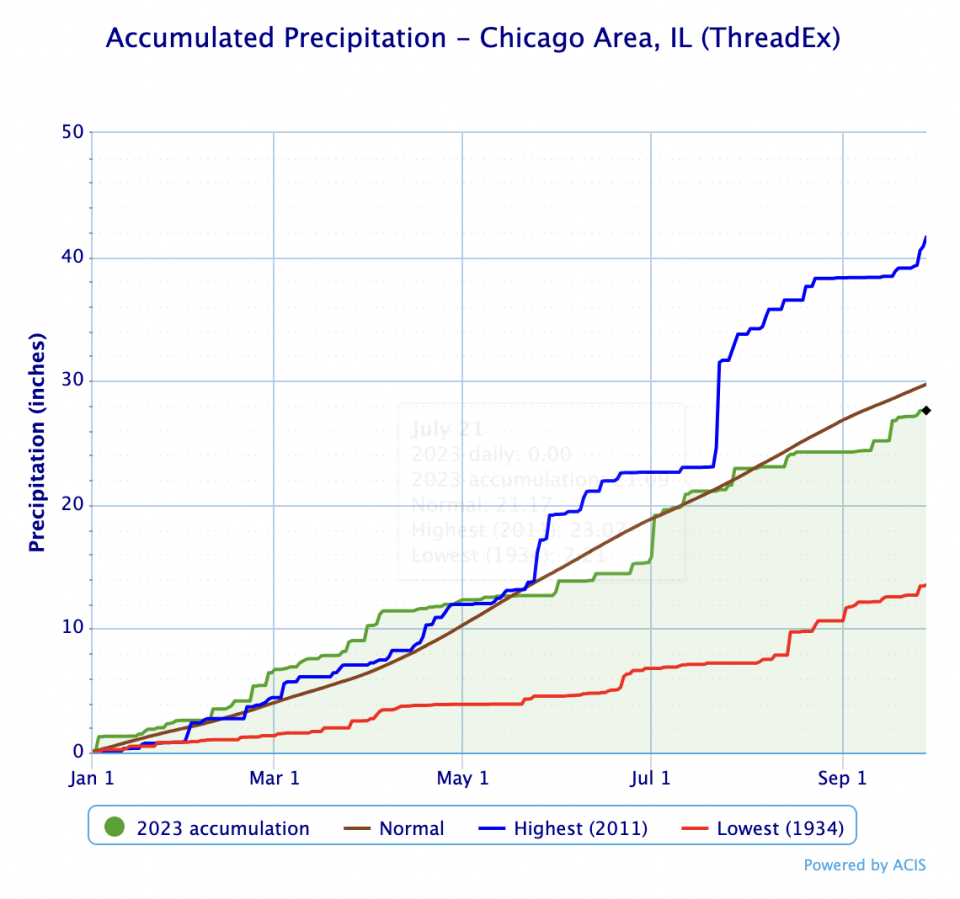Strong thunderstorms and hail give this county the worst weather in Illinois, report says
Cook County might have the worst weather in all of Illinois, according to a new report from digital data journalism outlet Stacker.com.
In its analysis, Stacker suggests a high number of severe weather events in the state’s most populous county make it the worst in Illinois.
“Proximity to Lake Michigan means Cook County, which includes Chicago, gets unsettling severe weather known as training thunderstorms,” Stacker wrote in its report. “Unlike typical quick single-cell thunderstorms, training thunderstorms can repeatedly build up in the same areas for hours and produce serious flooding. The name comes from the resemblance to train cars on railroad tracks.”
Cook County observed roughly 861 severe weather events between 2010 and 2020, averaging out to about 78.3 per year, Stacker says. According to the analysis, which is fueled in part by data from the National Oceanic and Atmospheric Administration, the most commonly observed events were thunderstorms with strong winds (28.2 events per year), hail (17.7 events per year) and flash floods (7.6 events per year).
The county’s total number of severe weather events sits near the top of the pack compared to the rest of the country’s most-afflicted counties, Stacker claims. No county experienced more severe weather events than El Paso County in Colorado, which observed more than 900 reported events between 2010 and 2020. High elevation there helps fuel frequent hail storms in the spring and summer, Stacker writes.
You can read Stacker’s full analysis for each state by visiting stacker.com/weather/county-most-severe-weather-every-state.
Cook County’s severe weather
Between June 2022 and 2023, Cook County observed at least 252 severe weather events, according to NOAA’s Storm Events Database, which is maintained through the National Centers for Environmental Information. More recent data is not yet available, the agency says.
Most events reported within the yearlong span were reported as thunderstorms with strong winds, hail and flash floods. Less common instances include tornadoes, excessive heat, high winds, rip currents, drought and ice storms.
So far in 2023, the Chicago area is just about keeping pace with expected precipitation rates, according to the National Weather Service. The region has observed about 27.61 inches of precipitation since January as of Sept. 27, falling just short of an average year’s 29.71 inches of precipitation through late September.

The Chicago area set a record in 2011 when nearly 41.61 inches of precipitation fell through the end of September, according to NWS archive data, which dates back to the late 1800s.
While most of Cook County is in the clear, large swaths of Illinois are experiencing “abnormally dry” conditions, according to the U.S. Drought Monitor. As of late September, more severe conditions are centered in northwestern Illinois and western Illinois, which are largely categorized as experiencing “moderate” or “severe” drought.
According to data through Sept. 26, St. Clair County is largely categorized as “abnormally dry,” though parts of neighboring Madison, Clinton and Washington counties in the metro-east have at least some areas of “moderate drought.”
Note: This graphic will automatically update as new data becomes available.
Moderate drought conditions can lead to declines in honey production, increases in irrigation use, small hay and grain yields, higher stress on trees and landscaping, inflated risk of wildfires and lower water levels in reservoirs and lakes, the U.S. Drought Monitor says. Severe drought conditions can cause dormant lawns, poor crop and vegetable conditions and outdoor burn bans, among other effects.
Conserving water or reducing its use during a drought can start with a few changes around the house, the Red Cross reports. If you live in an area where drought persists, consider watering your lawn before 10 a.m., using dishwashers and laundry machines with only full loads and leaving grass cut higher than usual to enhance root development.

